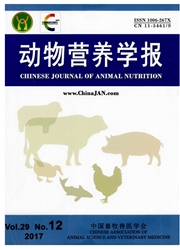

 中文摘要:
中文摘要:
本试验旨在探讨饲粮氮水平对牦牛体内不同部位氨态氮和尿素氮浓度的影响,以期了解牦牛机体对氮胁迫的适应性响应,并构建粗蛋白质进食量估测模型。采用4×4拉丁方设计,选取4头体重[(192±12)kg]相近的3岁去势健康牦牛。分4个试验期,每期21 d;4头牦牛分成4组,每组1头,分别饲喂4个氮水平的饲粮[以粗蛋白质水平(干物质基础)计,分别为6.45%、12.18%、17.81%和23.49%]。结果表明,1)瘤胃液氨态氮(RNN)、血浆尿素氮(PUN)、唾液尿素氮浓度以及尿中尿素氮(UUN)、尿中氨态氮日排泄量均随着饲粮氮水平的升高而极显著增加(P〈0.01);瘤胃液尿素氮(RUN)浓度有随着饲粮氮水平升高而增加的趋势(P〈0.10)。2)RNN、RUN和PUN浓度(mg/d L)以及UUN日排泄量(g/d)与牦牛饲粮蛋白质摄入水平密切相关,可建立以下估测牦牛粗蛋白质进食量(CPI,g/d)和可消化粗蛋白质进食量(DCPI,g/d)的模型:CPI=174.102+840.096RNN-3.068RNN2,CPI=185.818+47.744RNN+22.258RUN;DCPI=36.037UUN0.712,DCPI=-0.789+8.375UUN+101.275PUN。综上,饲粮氮水平对牦牛体内氨态氮和尿素氮浓度具有广泛的影响,由此建立的估测模型可为牦牛的放牧和管理提供参考。
 英文摘要:
英文摘要:
This study was conducted to investigate the effects of dietary nitrogen level on ammonia nitrogen( NN) and urea nitrogen( UN) concentrations in different parts of yaks,learn the response of yaks on nitrogen threatening,and construct predicting models for crude protein intake. A 4 × 4 Latin square design was used,and four healthy 3-year-old castrated yaks with similar body weight [( 192 ± 12) kg] were selected. There were four periods with 21 days per period; four yaks were divided into four groups with 1 head per group,and were fed diets with different nitrogen levels,which were 6. 45%,12. 18%,17. 81% and 23. 49%( calculated as crude protein levels,dry matter basis),respectively. The results showed as follows,1) with the increase of dietary nitrogen level,the concentrations of NN in rumen fluid( RNN),plasma UN( PUN),saliva UN( SUN),and the daily excretion of urinary UN( UUN) and urinary NN were extremely significantly increased( P0.01); however,UN in rumen fluid( RUN) only had a tendency to increase( P0.10). 2) There was close correlation among the concentrations of RNN,RUN and PUN( mg / d L),UUN daily extraction( g / d),and dietary protein intake level of yaks. Predicting models for crude protein intake( CPI,g / d) and digestible CPI( CPI,g / d) were as follows: CPI = 174. 102 + 840. 096RNN-3. 068RNN2,CPI = 185.818+47.744RNN+22.258RUN; DCPI = 36.037UUN0.712,DCPI =-0.789+8.375UUN+101.275 PUN. In conclusion,dietary nitrogen level has broad effects on NN and UN concentrations in yaks. Meanwhile,the predicting models developed by the present study may provide some references for yaks' farming and husbandry.
 同期刊论文项目
同期刊论文项目
 同项目期刊论文
同项目期刊论文
 Urea kinetics and nitrogen balance and requirements for maintenance in Tibetan sheep when fed oat ha
Urea kinetics and nitrogen balance and requirements for maintenance in Tibetan sheep when fed oat ha Apparent digestibility, rumen fermentation and nitrogen balance in Tibetan and Fine-wool sheep offer
Apparent digestibility, rumen fermentation and nitrogen balance in Tibetan and Fine-wool sheep offer Influences of dietary nitrogen and non-fiber carbohydrate levels on apparent digestibility, rumen fe
Influences of dietary nitrogen and non-fiber carbohydrate levels on apparent digestibility, rumen fe Changes of chemical composition to high altitude results in Kobresia littledalei growing in alpine m
Changes of chemical composition to high altitude results in Kobresia littledalei growing in alpine m Importance of functional ingredients in yak milk derived food from alpine region on health of Tibeta
Importance of functional ingredients in yak milk derived food from alpine region on health of Tibeta Seasonal variations in the fatty acid profile of milk from yaks grazing on the Qinghai-Tibetan plate
Seasonal variations in the fatty acid profile of milk from yaks grazing on the Qinghai-Tibetan plate Comparison of methanogen diversity of yak (Bos grunniens) and cattle (Bos taurus) from the Qinghai-T
Comparison of methanogen diversity of yak (Bos grunniens) and cattle (Bos taurus) from the Qinghai-T 期刊信息
期刊信息
